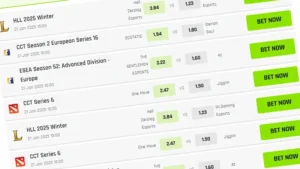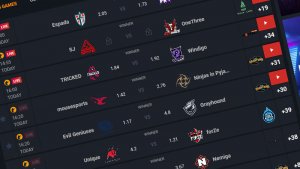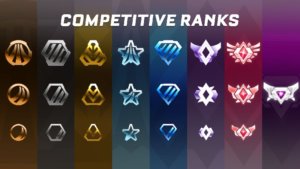Welcome to our authoritative blockchains list. This is the place where you’ll get to see the many different kinds of blockchains and understand the basics of how blockchains work.
Not only will we have blockchains explained in simple terms, but you’ll also get to see the application of this innovative technology so that you can enjoy the benefits of blockchains for anything from trading to gaming. So take a look at our blockchains list and get started.

© Paper
Blockchains Explained in Simple Terms
Imagine that a blockchain is an imaginary space with all kinds of blocks with data. As time passes, that space fills up with additional blocks of data records, organized in chronological order. In addition to that, the blockchains list is also secured by cryptographic proofs. These are then used for each transaction to ensure that every payment made for anything from a crypto game to an NFT marketplace is registered and secure. Are we catching on to any of that? No? Worry not. We will explain everything more understandably.
How blockchains work
When it comes to getting blockchains list explained, you have to understand that a blockchain witnesses a vast number of transactions for anything from trading Bitcoin to playing crypto farm games. When cryptocurrency is used in a transaction, the system tracks who was involved and how much cryptocurrency was used or not used. All crypto transactions made during a specific time frame are recorded into a file called a block, which is the fundamental element of a blockchain network or blockchains list.
The block stores all kinds of information elements, and while this information might seem significant, it doesn’t take too much storage space. There are a couple of different elements that a block would store:
- Transactions – a list of all transactions within a block
- Transaction counter – number of stored transactions on the block
- Block header – this is the information about the block itself
- Magic number – which is a specific value that helps determinate where the block stands in the network that the cryptocurrency is located
The transaction element occupies the most space because it provides the most information. After that comes the block header, which has a couple of sub-elements:
- Nonce – an encrypted number that a miner must solve to verify the block and close it
- Time – a timestamp that places the block on the blockchain
- Version – the version of cryptocurrency in use
- Previous block hash – the encrypted number (hash) if the last block’s header
- Hash Merkle root- hash of transactions in the Merkle tree of the current block
A single 32-bit number in the header is the nonce, and the miner uses random numbers to suggest its place in the hash. After the miner solves the hash by guessing the correct number, the network closes the block and generates a new one with a new header. This process then repeats itself.
Essentially the blockchain is a list of blocks that are solved and waiting to be solved by miners. Blocks individually can be looked at as specific algorithms. Every single one of them is different. When you put your miner to work, it uses its CPU and GPU power to solve these problems on the blockchain. Don’t forget that there are even mining games that can make this process a whole lot more enjoyable!
What do blockchains do?
The simplest way to say it is that blockchains record information in a way that makes it impossible to change, cheat, or hack the system. It compiles data on sales, tracks digital use and payments to content creators, and pretty much anything that might come to your mind.
Are all blockchains decentralized?
They are not; there are both centralized and decentralized blockchains. Only known and identified parties can transact on the ledger in a centralized network. However, on the decentralized network, anyone can transact on the ledger. For example, to maintain the decentralized ledger’s integrity, the Bitcoin’s network uses mining and proof-of-work.
Are all the blockchains the same?
At the moment, the blockchain list can be one of four different types:
- Public blockchains list – these have no restrictions. Anyone who has a connection to the internet can send transactions and become a part of the blockchain. Most of these blockchains offer economic incentives for those who secure them and show proof of work.
- Private blockchains list – these have restrictions so that they can be accessed only if the invite is given by network administrators. In order to distinguish between open blockchains and PTP(peer-to-peer) decentralized database applications that are not open on ad-hoc compute clusters, private blockchains usually use the term DLT (Distributed Ledger).
- Hybrid blockchains – these have a combination of both centralized and decentralized features, and the works of the blockchain are different on each hybrid blockchain.
- Sidechains – these are designed to run parallel to the original blockchain. Entries from the primary chain can be linked to these, and sidechains can also connect the information to each other. In a way, this allows the sidechain to operate on its own.
How many blockchains are there?
At the moment, there are over 10,000 cryptocurrency systems that use blockchain technology. We know, one would never guess that there is such a massive number of data being collected and mined through, but there is.

© Thehackpost
Can Blockchains be hacked?
Yes, unfortunately there have been many high profile hackings of blockchains over the years. Recently Binance lost over half a million dollars as a result of the hacking of its network. Thankfully, anyone who has read our Binance review will know that the brand has upgraded its security protocols to ensure that this doesn’t happen again.
Despite this, the basic blockchain is there to minimize such hacks. This is because it has built-in security features that always make hacking very difficult. After all, each block on the blockchain is digitally signed with a hash that is based on a mathematical algorithm.
Are Blockchains fully public?
It depends what kind of blockchain you are using. This is because there are public blockchains that are fully public, while private blockchains are fully private. It’s also worth noting that there are consortium blockchains that blend together both of the public and private types of blockchain. Just so you know, both Bitcoin and Ethereum are public types of blockchain. Conversely, Ripple is an example of a private blockchain.
How to invest in Blockchains
Given the rapid rise of blockchain technology, it’s little wonder that so many people are choosing to invest in blockchains. The good news it that there are many different ways that you can do this, and here are some of the most common:
Crypto trading
This is where you would visit either a crypto trading site or broker and then trade your regular fiat currency for a crypto coin, and from here trade the coin against other currencies. For example, you could buy Bitcoin and then speculate on its value against other cryptos such as Ethereum or even fiat currencies like the US dollar.
Trading is hugely popular given that cryptocurrencies have enjoyed a rapid rise in value over the past decade, although it’s worth noting that there have been many big crypto crashes too. It’s important to understand the difference between crypto broker vs exchange sites as they work in different ways. Plus you might be able to buy the crypto directly or simply speculate on its price movement by investing in a CFD (contract for difference).
Crypto staking
Lots of people will buy a crypto coin like Bitcoin simply as a store of value where its value rises over time. However, crypto staking is like a more advanced version of this as it allows you to make your crypto investment work for you.
Here you will be committing some of your crypto assets to the blockchain for a certain amount of time. This does the job of strengthening the blockchain by helping verify transactions, and in return you could be suitably rewarded with even more cryptos.
The downside of this is the fact that you won’t be able to withdraw your funds once you have staked it, and such a move could be catastrophic if there was a massive fall in the value of that crypto. Despite this, crypto staking remains a handy source of ‘passive income’ for many people.
What are some of the popular crypto game blockchains?
There are over 1000 games related to some blockchain, and you can play every single one of them right now. Of course, most of them would be a colossal waste of time since you would not have who to play them with, or they are just not wholly functional as pretty much anyone can start a blockchain game. But do not worry, as we will list some popular games made by reputable blockchain gaming companies that you could play to earn yourself either some cryptocurrency or NFTs; it is best to look for ones on the ETH network. Here they are:
- Splinterlands – a crypto card game that runs on the HIVE and WAX networks
- Axie Infinity – one of the most popular esports crypto games out there that runs on the RONIN and ETH networks. This game is the perfect option for those who want to experience something like Pokémon in the form of an NFT game.
- Alien Worlds – a science fiction game where you can explore planets and discover alien life that runs on the WAX and BSC networks.
- Farmers World – a farming simulator that runs on the WAX network.
- SecondLive – not to be confused with the famous game Second Life. This one runs on the BSC blockchain, while Second Life is an old game that shares the same ideas and does not run on a blockchain.
- Upland – this is a virtual property trading game where a player can buy, sell, and obviously, trade properties with other players. By being a digital landowner, you can earn UPX coins that you can utilize to mint NFTs.
Conclusion – Check back to our updated blockchain list
This guide has had blockchains explained in a way that will hopefully take away much of the mystery regarding this innovative technology. As a result, you will be able to enjoy the benefits of blockchains for a variety of purposes, whether it’s trading, staking or even enjoying some play to earn crypto games.
The key thing to remember is that while all blockchains will be based on the same security principles of consensus and cryptography, they are still subject to an element of risk. Much of this can be avoided by getting a better understanding of how blockchains work and knowing which coins to invest in and which to avoid.
Plus you should remember that the number of blockchains is constantly expanding and we will be updating our blockchains list accordingly. So make sure that you check back here to be first in line to enjoy all of the benefits of blockchains.




















